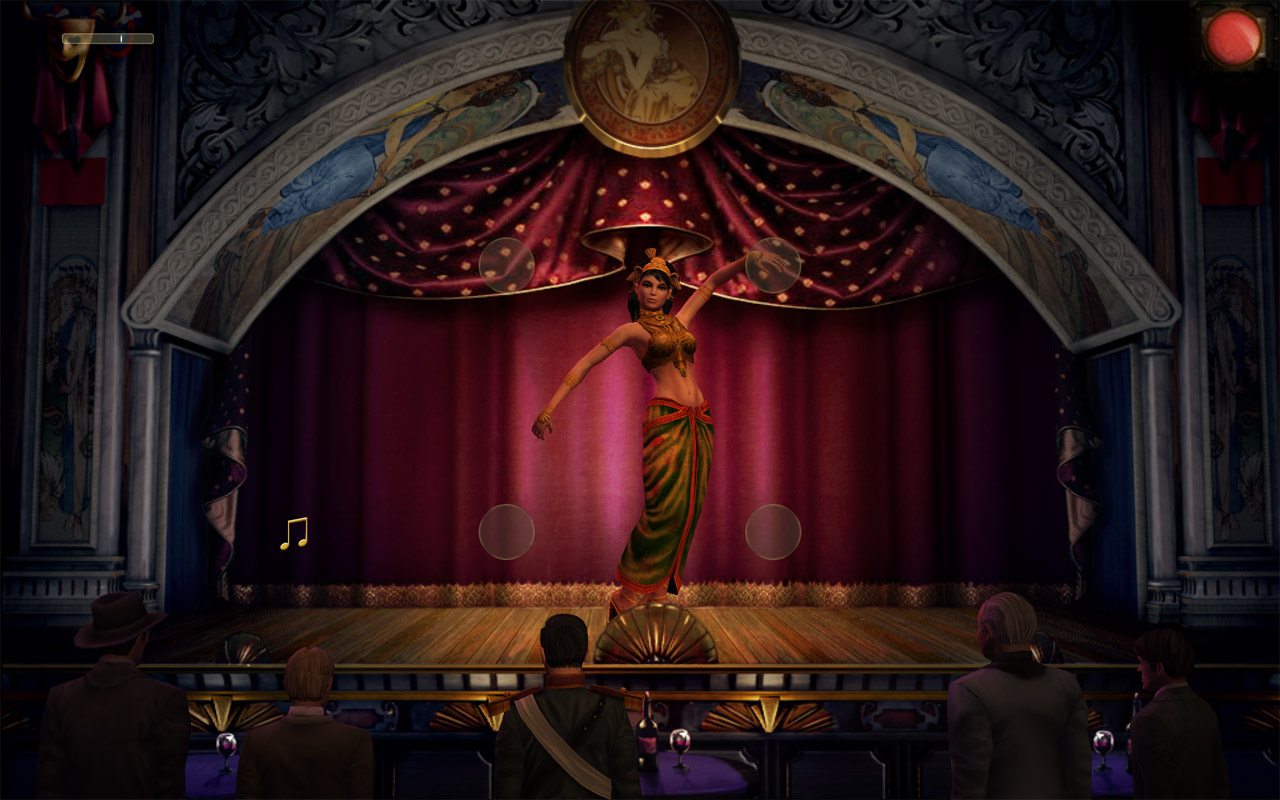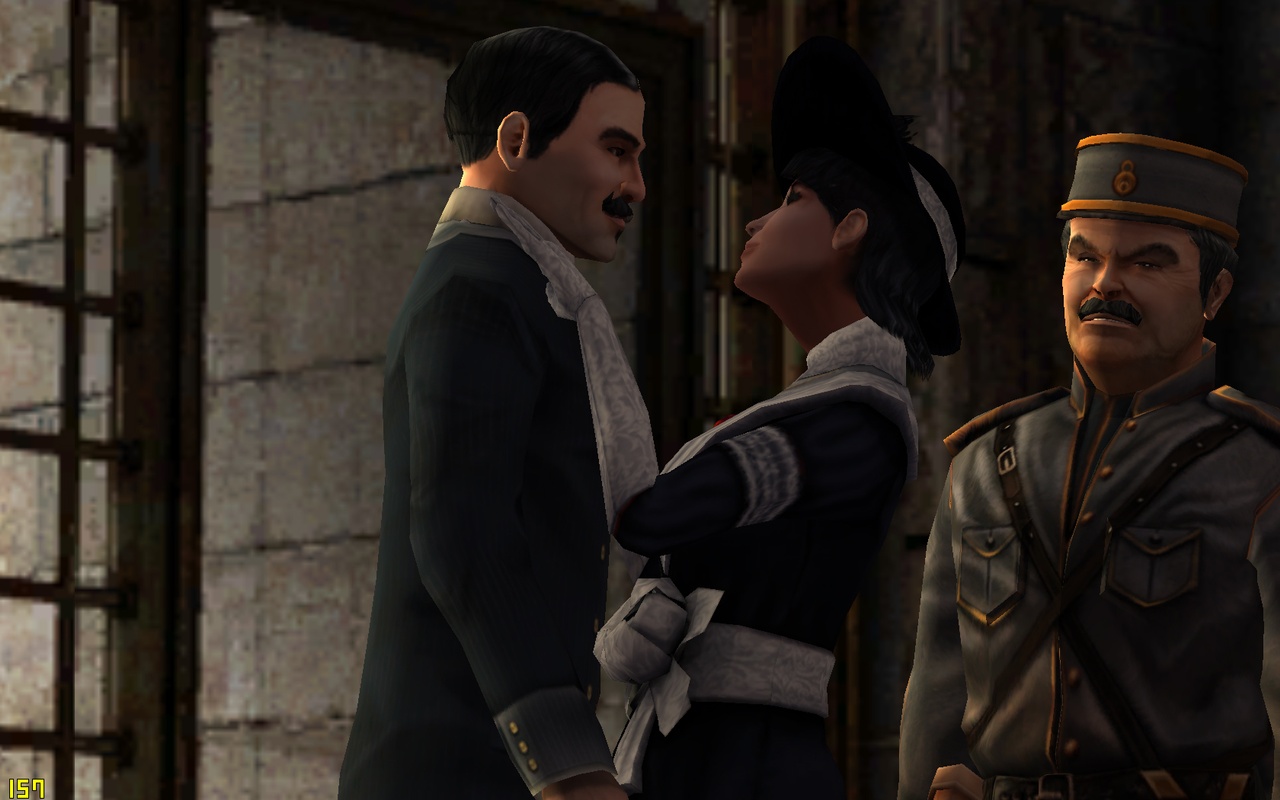Articles

Mata Hari Page Two

I spoke of being awarded points by these mini-games. Yep, Mata Hari is an adventure game with a scoring system, and the earnings coming in three flavors – Spycraft (awarded when finding optional, hard-to-find background items that the space bar won’t reveal, as well as for performing some side quests), Wealth (your accumulation of francs earned during dance performances) and Skill (awarded for completing mini-games with minimal retries). This feature, akin to the Indy Quotient, is a welcome one as there’s no real punishment for pretending that it doesn’t exist, and it does provide an incentive to actually play the mini-games. Additionally, the final tally impacts Mata’s ultimate fate. That’s right, there are alternate endings, though near as I can tell the only actual variable is the final write-up that appears in the in-game diary. The diary itself is an invaluable resource that stores the points you’ve racked up, tracks your narrative progress, serves as a recap of the story, and is otherwise extremely helpful in keeping you reminded of what you’re supposed to be doing. It’s similar to the description of events that you get when reloading a Telltale save game, an under-praised feature that got introduced with Wallace & Gromit’s Grand Adventures.

The game’s environments come as pre-rendered backgrounds which take on a realistic, albeit painterly style. As stated before, the portrayal of the setting is one of the game’s greatest assets, and the luscious artwork contributes heavily to the resultant atmosphere. The character models, which are detailed and generally differentiable, blend in well with their surroundings when not forced into close-up (think A Vampyre Story's dialog tree close-ups or how DeSinge’s laboratory looked in “The Siege of Spinner Cay” for the unfortunate effect these scenes have), and their animation cycles are fluid and expressive. The game isn’t able to pull off anything very impressive in terms of versatile character performances, with the limitations coming off most noticeably during sequences of extended dialog or when characters interact with background objects, which tend to look awkward and suffer from jerky transitions. The audio is more consistent, with a moody recorded soundtrack that really succeeds in further pulling you into the period. My only complaint there would be that, like the backgrounds they so effectively complement, the tracks start getting recycled a little too quickly. The English voicework is also solid, with the able actors having a strong script to work with.
Repetition is easily the game’s biggest enemy, and probably has more than a little to do with an attempt to wring out as much content as possible from a modest reservoir of assets. Mata spends a good majority of her existence in transit by rail and taxi, with Paris, Berlin, Madrid and Monaco being her usual haunts in the context of this game. While location hopping is in the nature of Mata’s quest, the incessant backtracking subjected to the player becomes very tedious. The fact that the majority of the locations are heavily reused (prepare to become intimately acquainted with European train stations and city plazas) isn’t a problem so much as the fact that you tend to end up doing the exact same thing in them over and over again. One early puzzle has Mata needing to find “inspiration” for a new dance move before Astruc will agree to set up a performance for her. So you go outside, observe a nearby NPC whose movement is interesting, gain the necessary inspiration token, and return to Astruc. The first time you do this, it’s an interesting, if completely extraneous, little task, but it is reprised every time the story calls for you to perform on stage again, with the only variation being the background character you need to click on.

Similarly, there are times where the backtracking gets out of hand. I could not count the number of times I was asked to go to a location, only to immediately be told upon arrival to go to a separate location in order to run one additional errand, and then come right back, after which the original task could finally proceed. True, under the surface this is how all adventure games operate, but there are only so many times you can get away with such gratuitous and undisguised examples of padding before it becomes a problem, yet Mata Hari overdraws from that account early and often. Logic issues also occasionally crop up as a result of all the location-hopping. At one point, Mata must contrive a way inside the British Embassy in order to a make pre-arranged meeting with a party within. While figuring out how to solve the puzzle, you may leave the location and perform, in the context of the story, weeks worth of travel, yet when you come back the gentleman is still patiently waiting at the embassy as if it were all still the same day. There was also a puzzle involving a painting that got me stuck for awhile because I was one step ahead of the game. I was supposed to have Mata look at said painting to give her an idea, but it turned out the game only registers this when looking at the painting after a certain conversation had been heard, when from a logic standpoint it really shouldn’t have mattered.
Still, while not all of the flaws are minor, the game ultimately works for the same reason a lot of adventure games do: because it’s a good yarn. Mata makes for a compelling lead, and the desire to see her story all the way through to the conclusion is ultimately what drives you forward, and the extent to which the gameplay doesn’t get in the way of that is the degree to which the game is successful. Don’t take this to mean that I consider the gameplay an obstruction; in fact, I think what I admire most about Mata Hari is that it is a prime example of a graphic adventure game that was made because the it was genuinely the best fit for the subject matter. There’s something nice about such a natural marriage between genre and premise, especially when the genre in question is such a commonly neglected one.
Mata Hari doesn’t set the world on fire, and it is not the most memorable adventure game to come out of 2008, but it is a competently crafted one centered around a worthy subject, and it is a welcome return to form for two veteran adventure builders who’ve been away for far too long. It doesn’t have much to offer players who aren’t fans of the genre or do not find the idea of a fanciful retelling of the dancer-turned-spy's story compelling, but if you’re looking for a decent adventure game that isn’t afraid to let its story carry most of the weight alone, doesn’t happen to be a cartoon comedy, and isn’t the exercise in intolerable blandness you unfortunately run the high risk of ending up with when you pick up an adventure game indiscriminately, then Mata Hari, despite its shortcomings, is worthy of your time.
A review by Jason, who can certainly relate to the tribulations of being an exotic dancer.
Mata Hari (or, Mata Hari: Betrayal Is Only a Kiss Away, as it was clumsily named in the States) is available on Steam for $9.99.